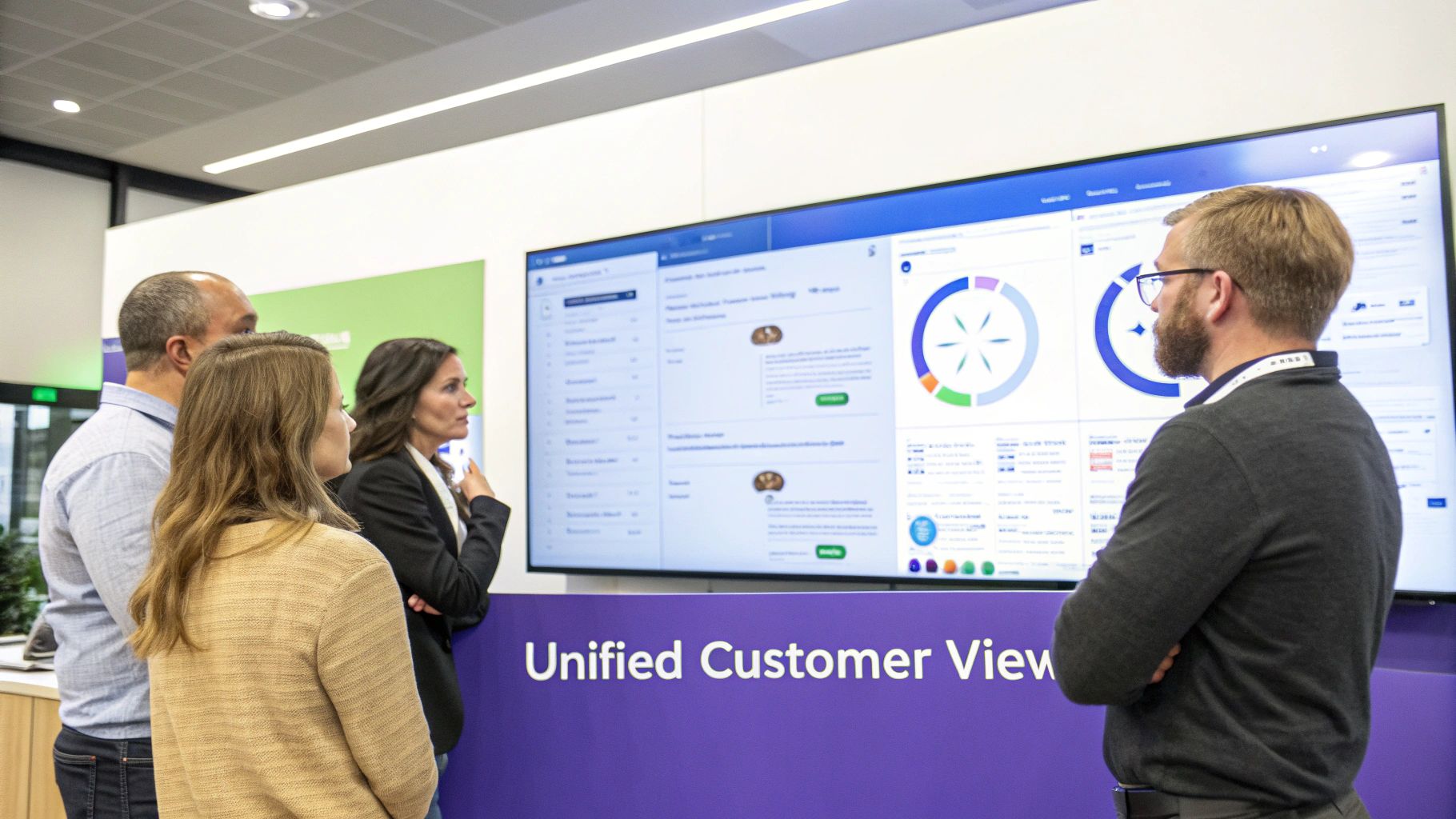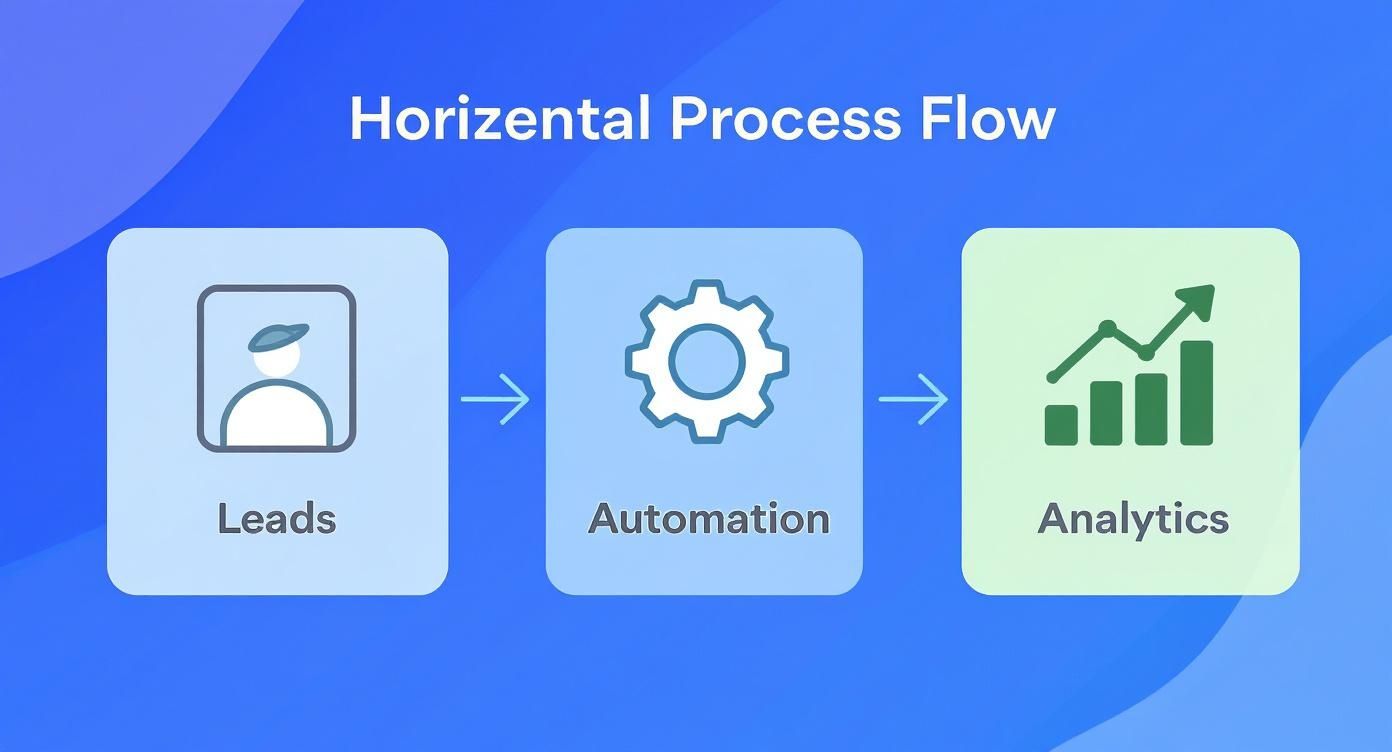Discover what is customer relationship management in marketing and how it drives engagement, retention, and sales with practical examples and actionable tips.
At its core, Customer Relationship Management (CRM) in marketing is a strategy—brought to life by technology—that helps you understand and manage every single interaction you have with your audience. Think of it as your business's central memory, keeping track of who your customers are, what they care about, and how they’ve connected with you in the past. This allows you to create highly personalized and consistent experiences.
What Customer Relationship Management Really Means for Your Marketing

A marketing professional analysing CRM data on a laptop, with charts and graphs in the background.
Let's cut through the jargon. Before you even think about software, think of CRM as a philosophy. It’s a fundamental shift in mindset—a commitment to building meaningful, lasting relationships instead of just chasing one-off transactions. Technology is simply the tool that makes this philosophy work at scale.
Imagine trying to personally remember the preferences, purchase history, and last conversation you had with hundreds, or even thousands, of customers. It’s an impossible task for any one person. A CRM system solves this problem by pulling every piece of customer data into one organized, accessible place.
This creates a single source of truth that aligns your entire go-to-market team, from marketing to sales to customer service. Suddenly, everyone is looking at the same customer, the same history, and the same context. The left hand finally knows what the right hand is doing.
The Shift from Data Points to Customer Stories
Without a CRM, your customer interactions are just a collection of disconnected data points: an email open here, a website visit there, a sales call logged in a separate spreadsheet. You see what happened, but you have no idea about the story of why.
A marketing CRM connects these dots. It weaves fragmented data into a coherent customer journey, showing you exactly how a lead discovered your brand, what content resonated with them, and what pain points ultimately led them to look for a solution like yours.
"Your job will not be taken by AI. It will be taken by a person who knows how to use AI. So, it is very important for marketers to know how to use AI.” — Christina Inge, Instructor, Harvard Division of Continuing Education
This deeper understanding is the whole game. As the team at Salesforce puts it, CRM provides the "memory, logic, and governance" that gives you the context needed for effective engagement. It’s what allows you to graduate from generic "batch-and-blast" campaigns to conversations that feel genuinely personal and relevant. For example, instead of sending a generic "check out our new feature" email, you can send it only to customers who have previously requested that exact feature.
In short, what customer relationship management in marketing does is provide the intelligence to deliver the right message to the right person at exactly the right time. This transforms your marketing from a series of isolated tactics into a coordinated growth engine built on real customer understanding.
Why CRM Is Essential for Modern Marketing Growth

A team of marketing professionals collaboratively working on a CRM dashboard, showing interconnected customer data points and growth charts.
Let's get real for a moment. Today’s customer journey is a chaotic mess. A prospect sees your ad on LinkedIn, watches your webinar a day later, then clicks a link in an email campaign—all before ever talking to sales. Without a central nervous system to connect these dots, you’re just throwing spaghetti at the wall.
This is where a CRM stops being a nice-to-have and becomes the absolute core of your marketing engine. It’s the unifying force that turns random interactions into a coherent story. You’re not just collecting data; you’re connecting it to build a genuine 360-degree view of your customer. This is the single source of truth that lets marketing, sales, and service finally operate from the same playbook.
That unified view isn’t just about making things tidy—it directly impacts your bottom line. Suddenly, you have the clarity to shift budget away from the channels that feel busy and into the ones that actually drive revenue. More importantly, research from Gartner shows that companies with a 360-degree customer view realize 15% to 20% improvements in customer satisfaction and retention.
Breaking Down Silos for Cohesive Experiences
When your teams are aligned, the customer wins. It’s that simple. Imagine a salesperson seeing that a lead just downloaded your latest ebook—they can skip the generic pitch and have a conversation that’s immediately relevant. Or picture your support team pulling up a customer's entire purchase history to offer help that’s actually helpful.
This is what personalization at scale truly means. You graduate from generic email blasts to hyper-relevant communication that speaks directly to a customer’s needs at that exact moment. This isn't just good for the customer; it's the critical link for stronger sales and marketing alignment, ensuring no lead gets left behind in a departmental handoff.
By unifying customer data, a CRM transforms your go-to-market strategy from a series of disconnected activities into a structured growth engine. It creates the foundation for predictable revenue by ensuring every customer interaction is informed by the last.
A Foundational Driver of Competitive Advantage
The market is voting with its wallet, and the message is clear. The global customer relationship management market was valued at $69.58 billion in 2023 and is projected to grow to $157.53 billion by 2030, a CAGR of 12.4%. This isn't just big enterprise spending; small and medium-sized businesses are realizing a CRM is non-negotiable for survival and growth.
Ultimately, a well-implemented CRM is one of the most significant competitive advantages you can build. It allows you to:
- •Increase Lead Conversion: Stop guessing. Understand lead behavior and nurture them through the funnel with the right message at the right time. For example, a company we worked with increased their MQL-to-SQL conversion rate from 12% to 18% in 90 days by implementing automated lead scoring in their CRM.
- •Boost Customer Retention: Create personalized experiences and offer proactive service that builds the kind of loyalty that keeps customers from looking elsewhere.
- •Improve Attribution: Finally get a clear, honest picture of which marketing efforts are generating your most valuable customers, proving your team's ROI.
In today's market, the companies that win are the ones that understand their customers most deeply. A CRM isn't just a tool to manage contacts; it's the engine that powers that understanding, making it an indispensable asset for any marketing team serious about sustainable growth.
What's Actually Inside a Marketing CRM?
So, what does a marketing CRM actually do? Forget the abstract definitions for a moment. In practice, a CRM isn't just one piece of software; it's your command center for understanding customers and acting on that knowledge. Think of it as the brain connecting all your go-to-market activities.
While every platform has its own bells and whistles, any CRM worth its salt is built on a few non-negotiable pillars. These are the core components that work together to turn raw data into real relationships and, most importantly, revenue.
Contact and Lead Management
This is the heart of the whole operation. It’s so much more than a digital address book; it’s a living, breathing record of every single person who interacts with your brand.
Each contact profile becomes a single source of truth, pulling in everything from their demographic info and communication history to their website activity and purchase data. It’s all there, in one clean view.
A well-organized contact database is the absolute foundation of effective marketing. With clean, accessible data, you can slice and dice your audience with incredible precision, making sure your messages always land with the right people. This takes work, which is why a routine CRM audit and data hygiene process is something every serious team has baked into their operations.
Marketing Automation and Campaign Tools
This is where your CRM goes from being a passive database to an active growth engine. Automation tools are designed to handle the repetitive, high-volume tasks that would otherwise be impossible, letting you engage leads at scale without sounding like a robot.
Key automation features you'll see include:
- •Email Nurturing: Set up timed email sequences that automatically go out to new leads—like someone who just downloaded an ebook—to guide them along their journey.
- •Lead Scoring: Assign points to leads based on their actions, like visiting your pricing page (+10 points) or opening multiple emails (+5 points). This helps you instantly spot who is most likely ready to talk to sales.
- •Dynamic Content: Change what people see on your website or in your emails based on what you already know about their interests or past behavior.
A powerful CRM gives you the tools to build personalized journeys for every customer. For example, a SaaS company can set up a workflow that automatically enrolls webinar attendees into a specific email nurture sequence, delivering relevant content that moves them closer to booking a demo.
Pipeline and Opportunity Management
For marketers, flying blind on what’s happening in the sales pipeline is a recipe for disaster. A CRM gives you a clear, visual map of your entire funnel, showing exactly where every potential deal is. You can track everything from the moment a lead becomes "Marketing Qualified" all the way to "Closed-Won."
Here's an example of what that looks like, with a visual pipeline dashboard from a major CRM like Salesforce.
This kind of visual clarity is priceless. It helps marketers see which campaigns are actually generating valuable opportunities and pinpoint exactly where deals might be getting stuck.
Analytics and Reporting Dashboards
Finally, a CRM is how you prove what’s working and what isn’t. Instead of getting lost in spreadsheets for hours, you get instant access to analytics dashboards that measure the metrics that matter.
These reports pull data from across the entire platform to show you things like campaign ROI, lead conversion rates, and customer lifetime value. This data-driven feedback loop is essential for constantly tweaking your strategy and, crucially, proving marketing's direct impact on the bottom line.
How to Build and Implement a Winning CRM Strategy
A powerful CRM is just a tool; the real magic comes from the strategy behind it. Simply buying software without a clear plan is like buying a high-performance engine without a car—you’ve got the power, but no way to actually go anywhere. A successful rollout has less to do with the technical setup and everything to do with clear goals, team adoption, and measurable business impact.
The process kicks off long before you migrate a single contact. It starts with asking tough questions. What specific business problem are we actually trying to solve? How will this make our marketers' and sellers' lives genuinely easier? Without solid answers, your CRM risks becoming an expensive, glorified address book.
The infographic below shows how a marketing CRM should function, moving contacts from initial interest to loyal customers.

Infographic about what is customer relationship management in marketing
This visualizes the journey, showing how a CRM turns scattered interactions into a systematic, data-driven process.
Phase 1: Define Your Goals and Secure Buy-In
Before you even look at a single platform, you have to define what victory looks like. Your goals need to be specific, measurable, and tied directly to revenue. Forget vague objectives like "improve marketing." Get granular.
- •Goal Example 1: "Reduce average lead response time from 24 hours to under 1 hour within Q3."
- •Goal Example 2: "Increase marketing-sourced pipeline contribution by 15% in the next six months."
With clear goals in hand, you can get buy-in from leadership and—more importantly—from the teams who will be in the CRM every single day. You have to frame this not as another tool to learn but as the solution to their biggest headaches, like digging for lead context or mind-numbing manual data entry.
Phase 2: Plan Your Data Migration and Processes
Data is the fuel for your CRM engine. A messy, incomplete data migration will cripple your strategy from day one. Your plan has to cover data cleaning, deduplication, and carefully mapping fields from old systems to the new one. This is non-negotiable if you want to avoid the classic "garbage-in, garbage-out" disaster.
At the same time, you need to map out your core processes. How, exactly, will a lead get handed from marketing to sales? What criteria will you use for lead scoring? Keep it simple to start. Over-engineering your workflows creates friction and kills user adoption before you even get started. A great starting point is exploring what HubSpot is and how its clean interface can simplify these initial process designs, especially for growing teams.
Phase 3: Train Your Team and Drive Adoption
Your CRM launch isn't the finish line; it’s the starting pistol. Effective training is everything. Don't just show your team how to click the buttons; show them why it helps them hit their targets and makes their jobs better.
A successful CRM rollout focuses on human behavior first and technology second. If your team doesn't see how the tool makes their job easier or more successful, they won't use it. The best strategy is one that gets adopted.
Start with a small group of champions—early adopters who can help their peers and build momentum. Provide ongoing support, and be sure to celebrate early wins publicly. For instance, when a salesperson closes a deal faster because they had the full marketing engagement history at their fingertips, shout it from the rooftops. This turns abstract benefits into tangible proof, making the CRM an indispensable part of your growth engine.
CRM in Action: Real-World Marketing Victories

A group of marketing professionals celebrating success in front of a dashboard showing positive growth metrics and customer engagement.
Theory is great, but seeing a CRM actually drive results is what makes the lightbulb go on. Let's get out of the weeds of features and look at how real businesses use customer relationship management to solve nagging problems and score measurable wins. These stories show exactly how a unified data source becomes a powerful growth engine.
Picture an e-commerce brand tearing its hair out over abandoned carts. It’s a classic, frustrating problem. Using their CRM, they track user behavior and see exactly which products a customer looked at before bouncing. This isn't just data—it's a trigger.
Now they can launch automated, highly personal email sequences. We’re not talking about a generic "You left something behind!" email. They can show the exact product, offer a tiny discount, or even suggest similar items based on what was in the cart. According to data from Klaviyo, cart abandonment emails have an average open rate of around 40% and can recover 3-14% of lost sales. That's a direct, quantifiable return powered by smart CRM automation.
From Disconnected Leads to a Cohesive Funnel
Now, let's pivot to a B2B SaaS company. They run a great webinar and get hundreds of sign-ups, but their follow-up is slow, generic, and totally ineffective. Sound familiar? By tracking attendance and engagement right inside their CRM, the marketing team can instantly see who stayed for the whole show versus who bailed after ten minutes.
This simple segmentation is a game-changer. The most engaged attendees? They get fast-tracked straight to the sales team, who already have the context that this is a hot lead. Everyone else gets dropped into a targeted nurture campaign related to the webinar topic, keeping them warm without wasting a salesperson's time.
A well-implemented CRM turns scattered marketing activities into a predictable revenue machine. By connecting every touchpoint, it gives you the intelligence to focus your efforts on the highest-potential opportunities, dramatically improving conversion rates.
The results are staggering. Companies that nail this kind of lead tracking and nurturing often see demo bookings from events jump by 40% or more. This isn’t a lucky break; it’s a repeatable process built on a foundation of clean data.
Platforms like Salesforce continue to innovate in this area, even launching a generative AI benchmark to evaluate large language models specifically for CRM, focusing on accuracy and cost. As competition heats up, having this level of data-driven sophistication isn't just an advantage—it's essential for survival.
By looking at these specific tactics and their outcomes, you can start to see how these same strategies could apply to your own business. A CRM isn't just for organizing contacts—it's about turning that organization into real, measurable marketing victories.
Frequently Asked Questions About CRM in Marketing
Even with a solid plan, diving into the world of customer relationship management is going to bring up questions. Let's tackle some of the most common ones marketers run into, so you can move forward with confidence.
What Is the Main Difference Between a CRM and a Marketing Automation Platform?
This is easily the most common point of confusion, and for good reason—they have a lot of overlap. But their core jobs are fundamentally different.
A CRM is your system of record for the entire customer relationship. It’s the central database tracking every interaction from their first website visit to their most recent support ticket. A marketing automation platform, on the other hand, is built to execute top-of-funnel campaigns at scale, like email nurturing, lead scoring, and landing pages.
Think of it this way: your marketing automation tool is the expert angler casting the net and reeling in promising leads. The CRM is the ship's log, recording the entire history of every fish you've ever caught, where you found them, and what they're worth to you.
To clear this up even further, let’s break down their primary functions side-by-side.
CRM vs Marketing Automation Platform: A Quick Comparison
While modern platforms often blend these capabilities, understanding their core design focus is key to building the right tech stack. The CRM is relationship-focused, while the marketing automation platform is campaign-focused.
| Feature | CRM Focus | Marketing Automation Focus |
|---|---|---|
| Primary Goal | Manage and deepen customer relationships across the entire lifecycle. | Generate, nurture, and qualify leads at the top of the funnel. |
| Core User | Sales, Customer Success, Account Management | Marketing Teams (Demand Gen, Content, Ops) |
| Key Data | Deal stages, contact history, support tickets, communication logs. | Email opens, click-through rates, website behavior, lead scores. |
| Main Activities | Pipeline management, contact logging, forecasting, customer service. | Email campaigns, lead nurturing workflows, social media scheduling. |
Ultimately, you need both. They are two sides of the same revenue coin, working together to create a seamless journey from prospect to loyal customer.
How Can a Small Business with a Limited Budget Get Started with CRM?
You absolutely don't need an enterprise-level budget to get value from a CRM. In fact, many of the best platforms, like HubSpot, offer powerful free or low-cost plans specifically for small businesses. These "freemium" tiers give you all the essentials to get started.
The trick is to start simple. Don't get distracted by a thousand features you don't need yet. Nail the fundamentals first:
- •Centralize Your Contacts: Get every customer and prospect out of scattered spreadsheets and into one clean, organized system. This is non-negotiable.
- •Track Your Deals: Build a simple sales pipeline to see, at a glance, how prospects are moving toward a decision.
- •Log Key Interactions: Make it a team habit to jot down notes from important calls, meetings, and emails.
This basic discipline will pay for itself long before you ever need to upgrade to a paid plan.
A CRM's value isn't determined by its price tag but by the consistency of its use. A free CRM that's updated daily is infinitely more powerful than an expensive one that gathers dust.
Can a CRM Really Help with Customer Retention?
Absolutely. It’s one of the most underrated retention tools you have. While most people think of CRMs for customer acquisition, their real power often lies in keeping the customers you've already won. According to Forrester, improving the customer experience can increase customer retention by up to 17%.
A CRM gives your team a complete historical view of every customer, which is the context they need to deliver proactive, personalized service.
Imagine your support team can instantly see a customer’s entire purchase history and past support tickets. They can solve problems faster and without asking frustrating, repetitive questions. Or your marketing team can see purchase data to send hyper-relevant cross-sell offers or loyalty rewards, making customers feel understood, not just marketed to.
As Salesforce puts it, this unified view provides the "memory, logic, and governance" to strengthen relationships long after the initial sale. This is what turns one-time buyers into long-term brand advocates, directly boosting customer lifetime value and slashing churn.
Ready to stop guessing and start building a predictable growth engine? Altior & Co. specialises in fixing broken go-to-market strategies for B2B SaaS and Fintech companies. We'll help you align your teams, clean up your data, and turn your CRM into your most valuable asset. Book your Revenue Funnel Review today.


